Raphael Exam - Great Masters
1/25
There's no tags or description
Looks like no tags are added yet.
Name | Mastery | Learn | Test | Matching | Spaced |
|---|
No study sessions yet.
26 Terms
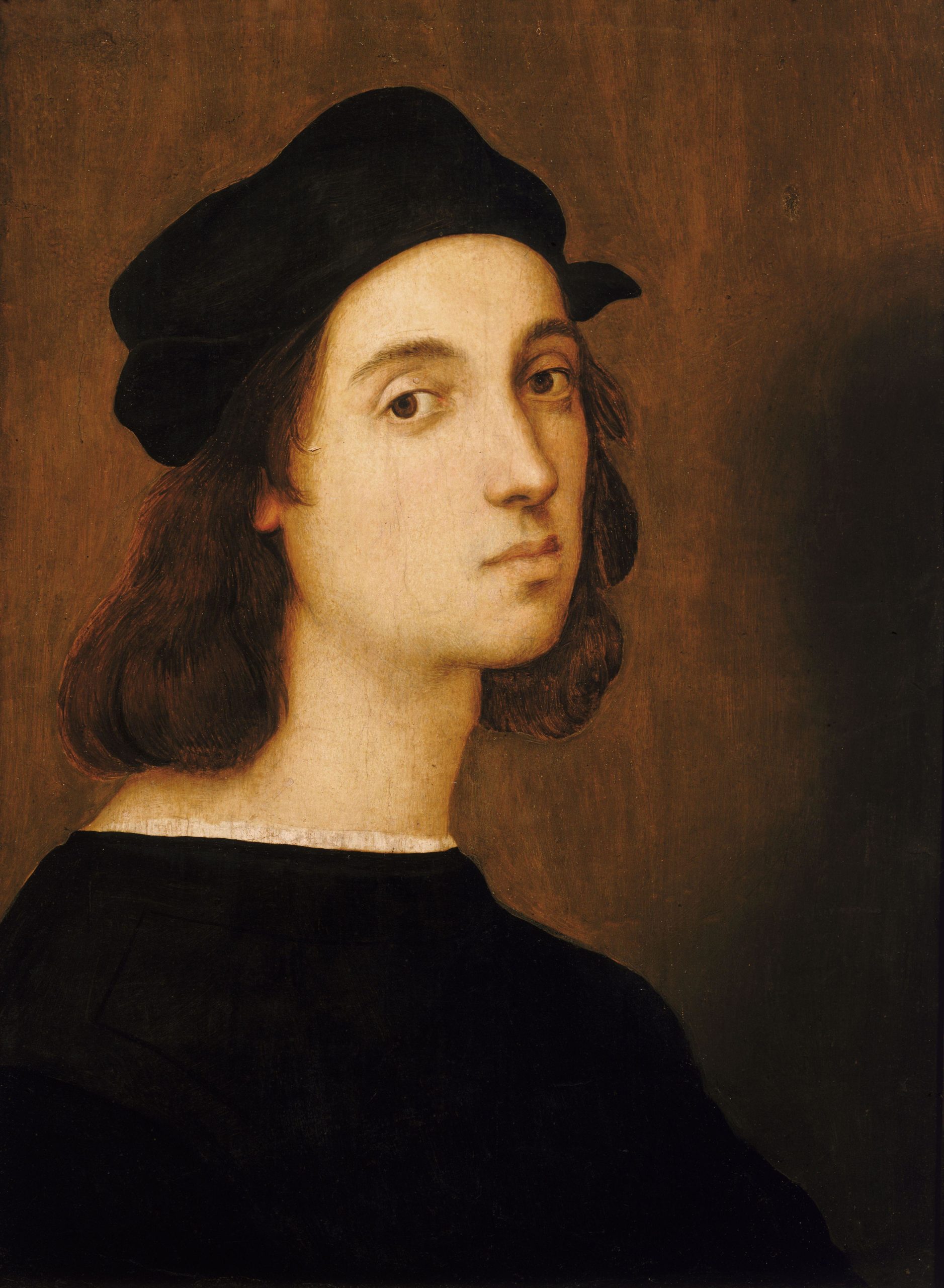
Raphael Santi (1483- 1520)
Born in Urbino on Good Friday and died in Rome on good friday
Wealthy town comes under the leadership under
one of the most lively centers
bright blue light in urbino, no haziness
Giovani Santi (father) and mother died young, daughter to a wealthy merchant. His mother nursed all of her children (uncommon of the time)
Giovanni was a painter and poet, court painter to Frederico
best known for his biography of the Duke (Cronoca)
dedicated to the duke’s son
Raphael spent his early life in or near the court
Likely learning in his father’s studio learning fresco and oil and assisting him as an apprentice occasionally.
Mother dies when he is 8, father dies when he is 11
Pietro Perugino (1450-1523) becomes his teacher after his father dies
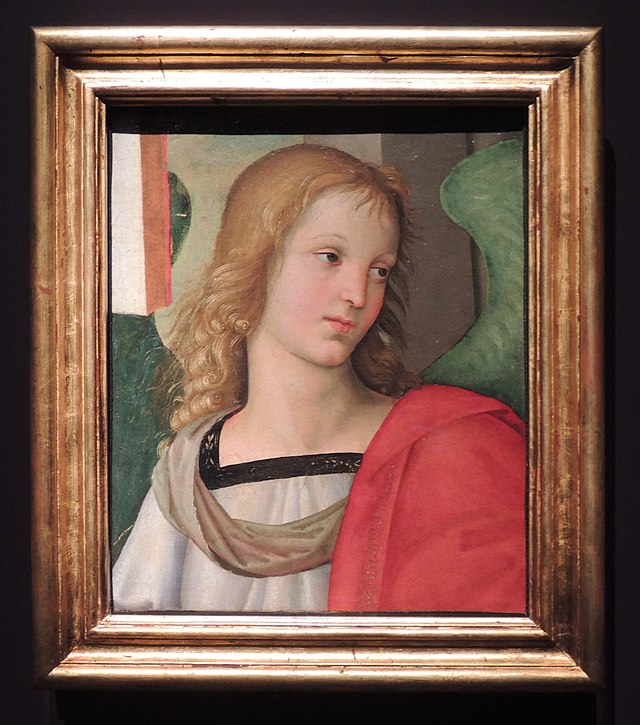
Angels, Baronci Altarpiece
1500
oil on wood
Sant Agostino, Città di Castello, Louvre/Brescia
Raphael’s first recorded commission
dedicate to Nicholas of tolentino (a hermit)
the angels showcases his interest in complementary color and clear lines
strawberry blond and fair skin typical of people of the Adriatic coast
There was a preliminary drawing for this work
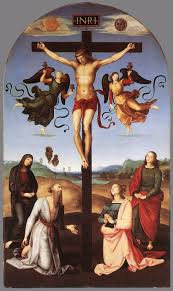
Crucifixion
Città di Castello Altarpiece
c. 1502
oil on wood
National Gallery, London
First signed work
about 20 at the time
formed the central part of an altarpiece inset into a large stone frame
dominivo gavari commissioned
mary magdalene, john evangelist, The Virgin, St. Jerome depicted in the painting
Angels catch Christ’s blood in chalaces
sun and moon appear above the figures as in the biblical story
perhaps St.Jerome is placed her because this was for a Dominican church
The letters are painted in silver (his signing at the bottom)
Often referred to as the mond altarpiece
shows an adherence to his master also shows his independence (far reaching landscape, brighter color palette)
For San domenico
May have been inspired by Perugino in the composition (double decker construction)
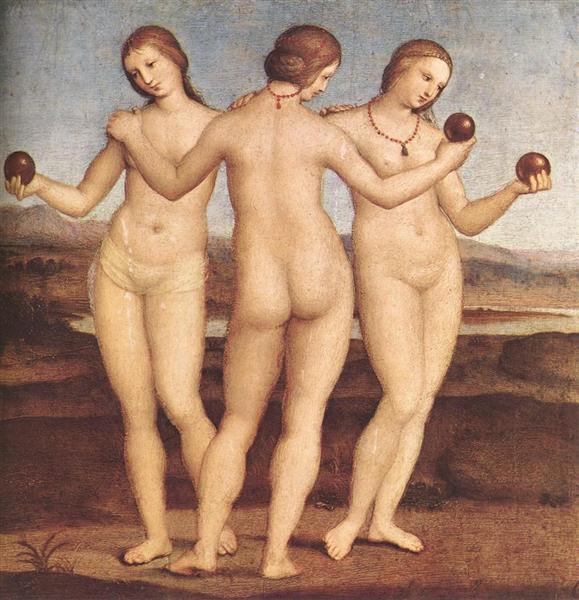
Three Graces
c. 1503-04
oil on wood
17.1 x 17.1 cm
MuséeCondé, Chantilly, France
Secular
likely connected to knights dream because of a poem that connects them
raphael’s first study of the female nude
not based on a living model based on a sculpture in Sienna
In Sienna in 1503 helping to decorate the library and saw the sculpture
attendance of Venus, representing Chastity, beauty and love
guard hera’s garden (hold apples)
northern inspired
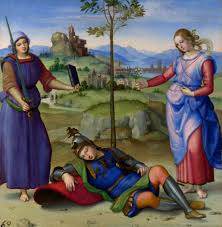
Vision of a Knight, (or The Knights Dream)
1503-04, oil on wood
17.1 x 17.1 cm
National Gallery, London
Secular
Venus (right) and Minerva (left)
Young knight below a laurel tree (symbolizing Victory and achevement)
Minerva/virtue holds a book
Venus/grace holds white flowers
allegory of the choice between virtue and grace like Hercules (he chose virtue)

The Marriage of the Virgin
1504
Oil on round headed panel
174 x 121 cm
Brera, Milan
5ft x 3ft
commissioned by albentzini
purchased the chapel dedicated to St.Joseph
Depicts the marriage between the two
Important that they hold sticks (whoever’s rod flowers or has a perching dove will be Mary’s husband)
in front of the temple getting married
painting is very similar to perugino
Raphael signs the temple
Mary is depicted in red and blue wearing shoes (focuses on the ring)
behind the virgin are other young virgins from the temple
inspired by the tempietto by his uncle Vermonte
The tempietto references the dome of the rock in Jerusalem
This is important as Mary and Joseph are both descendants of David
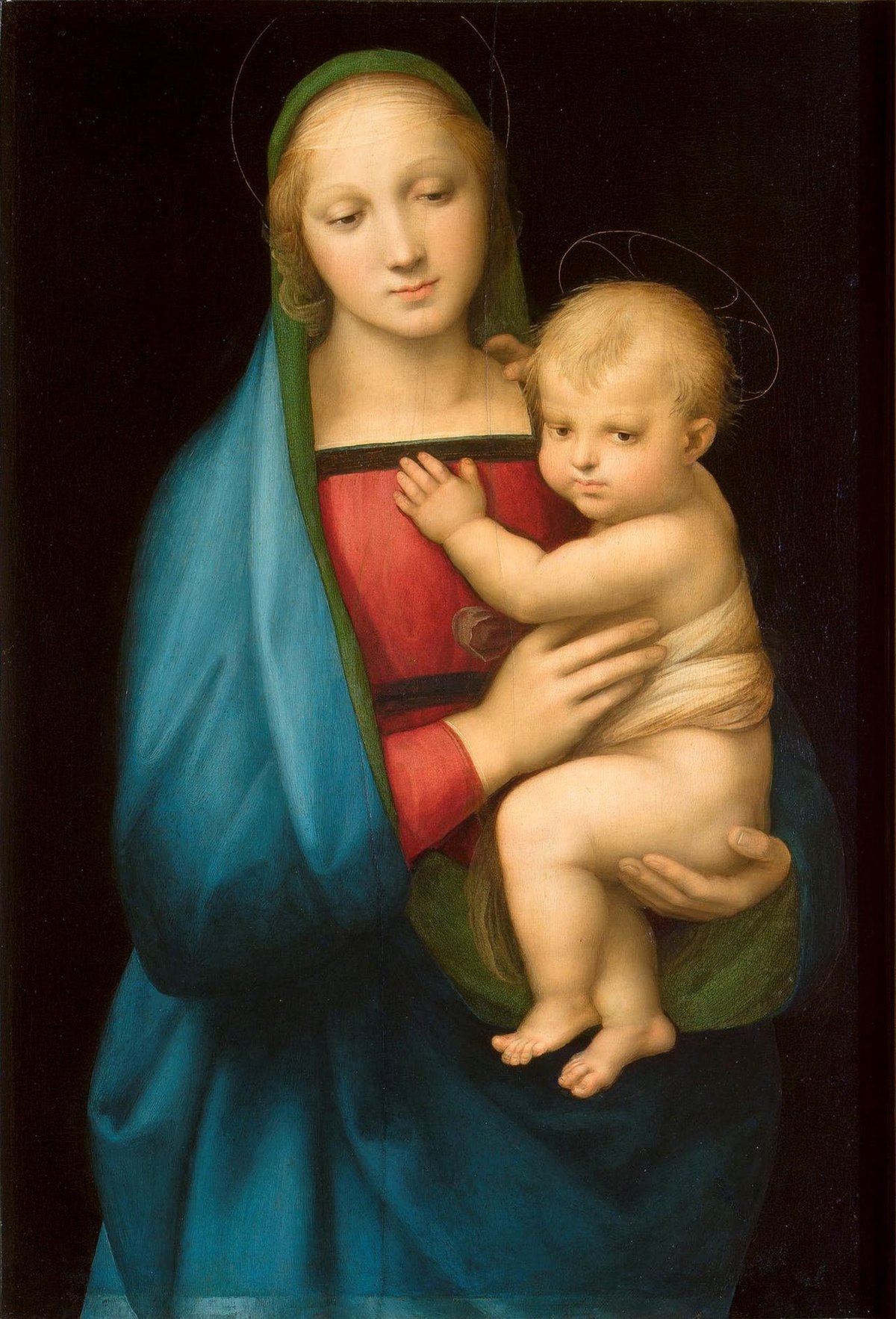
Madonna of the Grand Duke
c. 1505
Oil on wood
84 x 55 cm
Palazzo Pitti, Florence
33 x 22in
The grand Duke of Tuscany (Ferdinand III) owned the work and brought it everywhere with him
The figures are much fleshier and a sort of sfumato that sets him apart from his teacher and influenced by Leonardo
There is no hard edge
The Christ child has a strange confidence
VM is also unadorned
less decorative in style than his earlier works
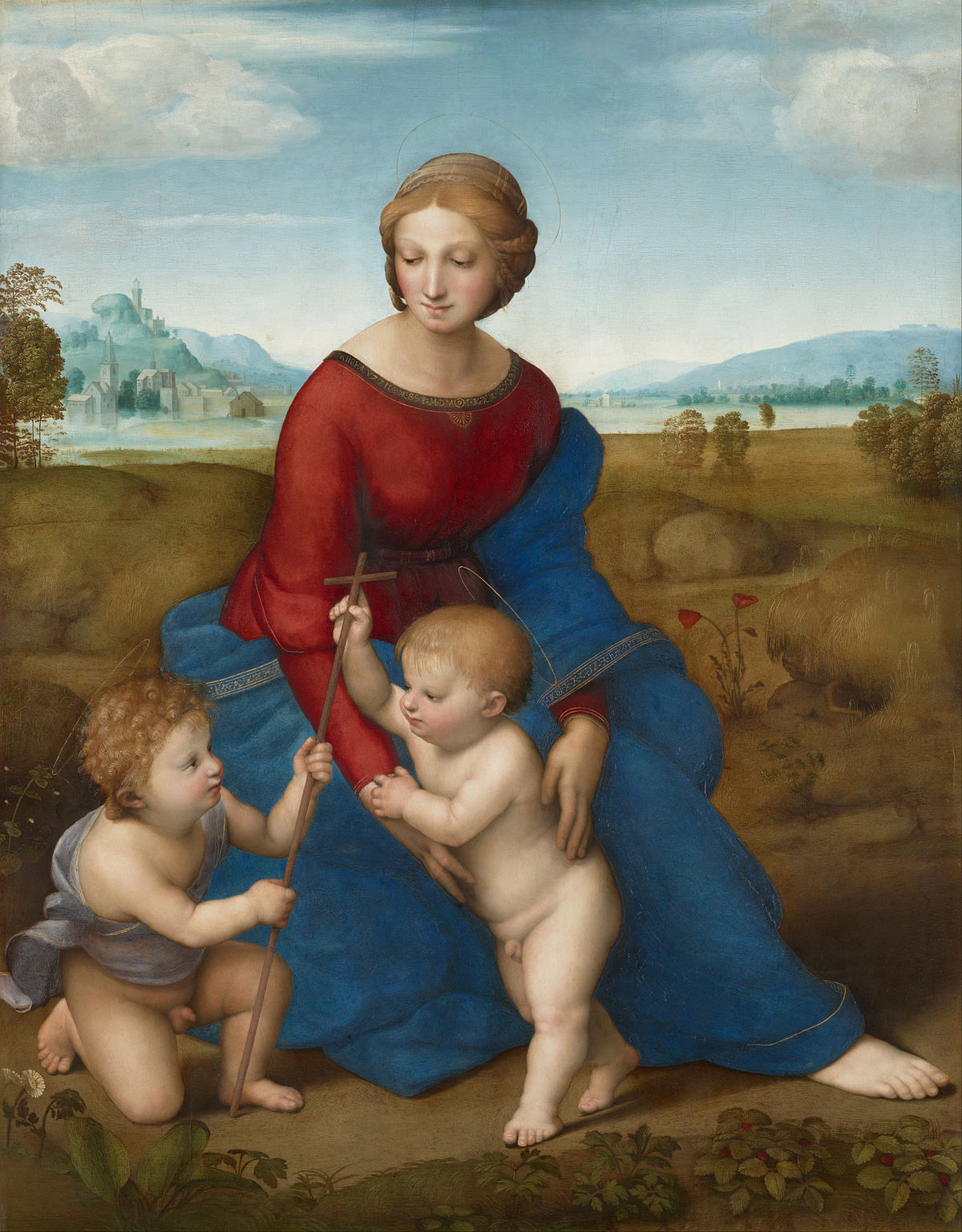
Madonna del Prato (of the Meadow)
c. 1505, Oil on wood
113 x 88 cm
Kunsthistorisches, Vienna
Pyramidal structure inspired by Leo’s Madonna and Child and St. Anne
The twisted structures of the figures shows inspiration of Michaelangelo
The light skin and hair typical of early Raphael
The Christ child has a weirdly mature body language/pose
Similarly posed figures in Leonardo’s Virgin of the Rocks
There is a clear light
Rich and saturated jewel tones
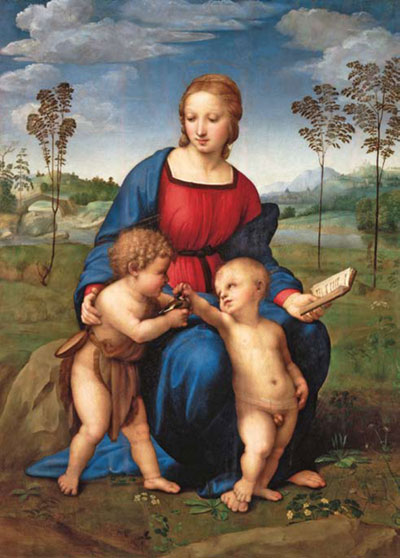
The Madonna of the Goldfinch
c. 1505
Uffizi, Florence
43 x 33 in
painted for Lorenzo Nasi his friend for his wedding
Christ and John the Baptist offering a goldfinch to Christ
Inspired by Michaelangelo’s Bruge Madonna
Here she reads
Christ child is standing in a contrapposto pose
Goldfinch represents passion
Painting was damaged in the collapse of the Nasi home
restoration took 10 years
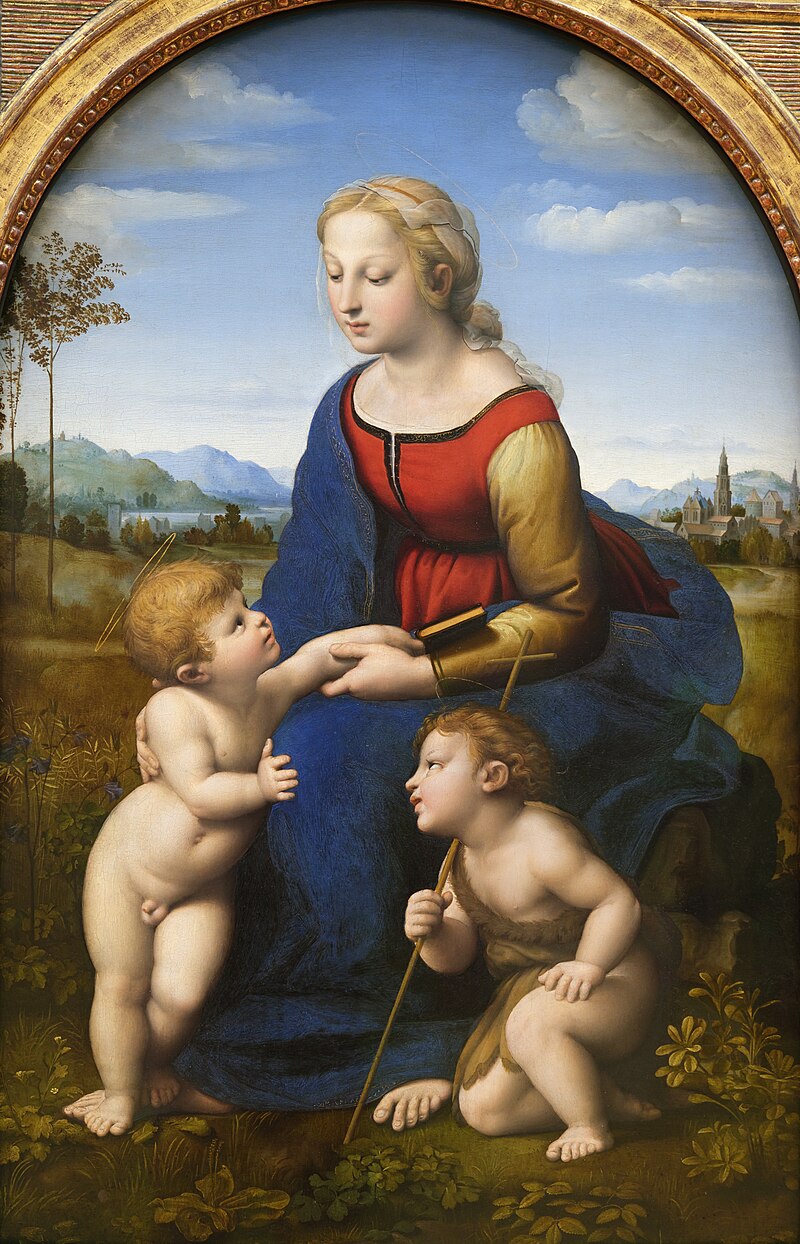
La belle jardinière
c. 1507
Louvre, Paris
Oil on panel
arched top painting
3rd painting in the series
Madonna remains the same strawberry blond woman
The child figures switch places
Dersartzi commission
Culmination of the features of the earlier works
John the Baptist does not engage with the Christ child at all
Christ child looks at the VM
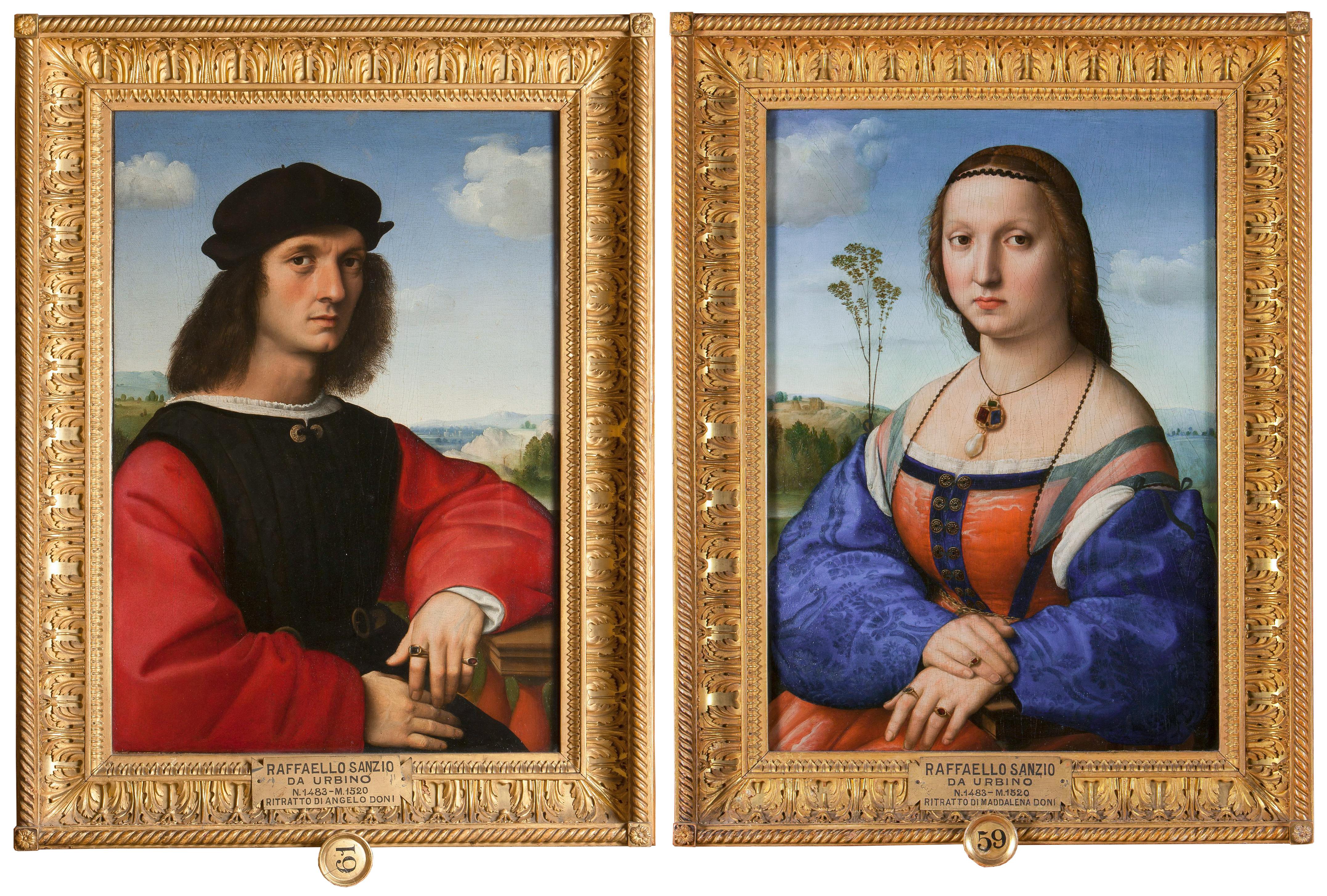
Portrait of Agnolo and Maddalena Strotzi Doni
1505-06
Oil on wood
63 x 45 cm
Palazzo Pitti, Florence
One of the greatest influence by Leonardo
24 x 18 in
Angnolo was a wool merchant
Maddalena was 15 when marries
Wedding portraits
Were originally hinged with Angnolo on the left (read first)
Maddalena’s portrait is strikingly similar to the Mona Lisa
Clarity of light and the line
Far more saturated hues
The sprezzatura and Jewels express her wealth
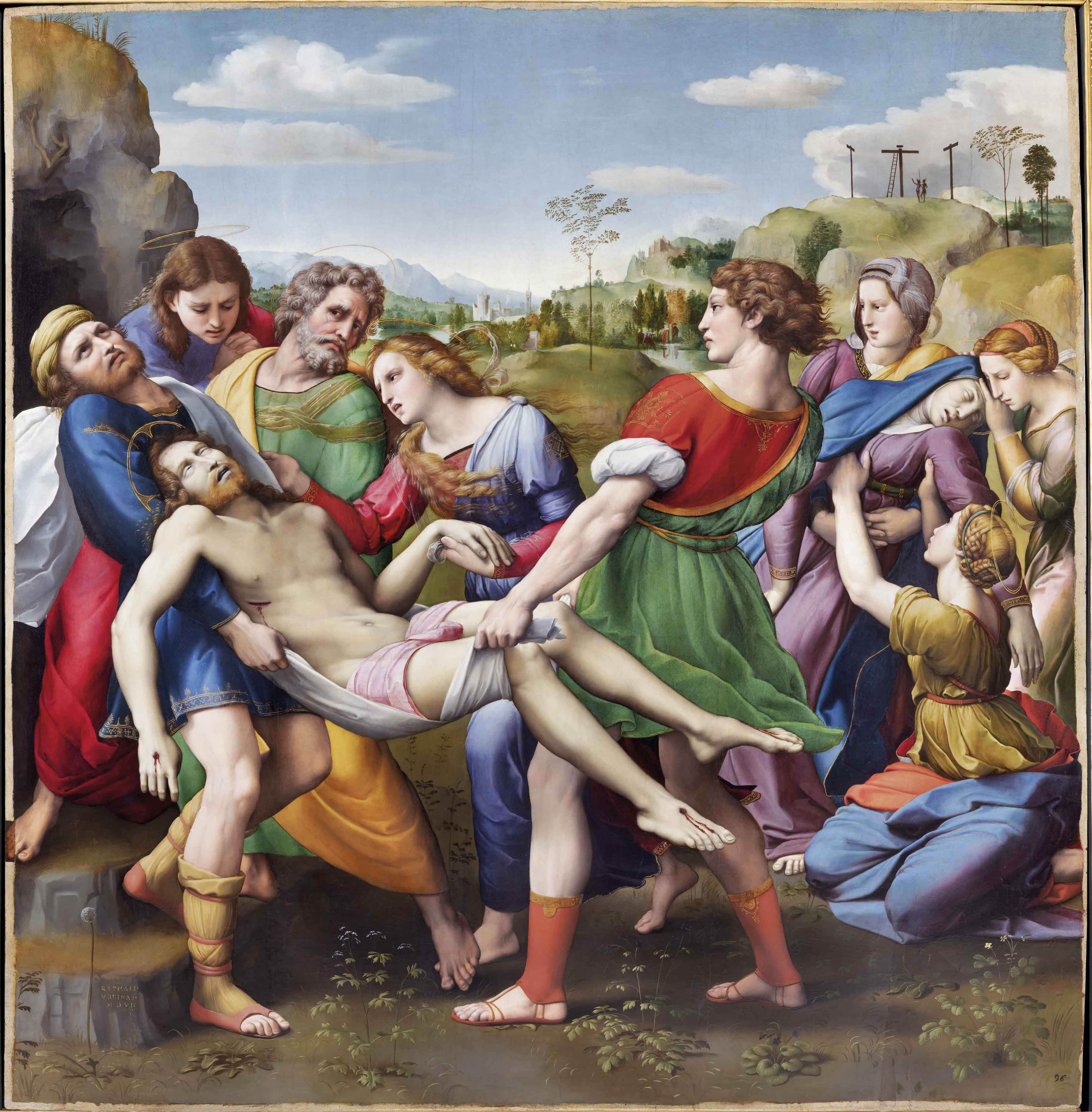
The Deposition of Christ
1507
Oil on wood
184 x 176 cm
Galleria Borghese, Rome
Atlaena commissioned
For a burial chapel (For the murdering of her son Grifonetto)
The predella depicts the 3 virtues
Entombment scene
Group of 3 women on the right support the fainting VM
The two men without halos carry the body of Christ
Mary Madeline on the left side
The you figure on the right is believed to be Grifonetto
Turns to Michaelangelo for inspiration here
Work was restarted in 2005
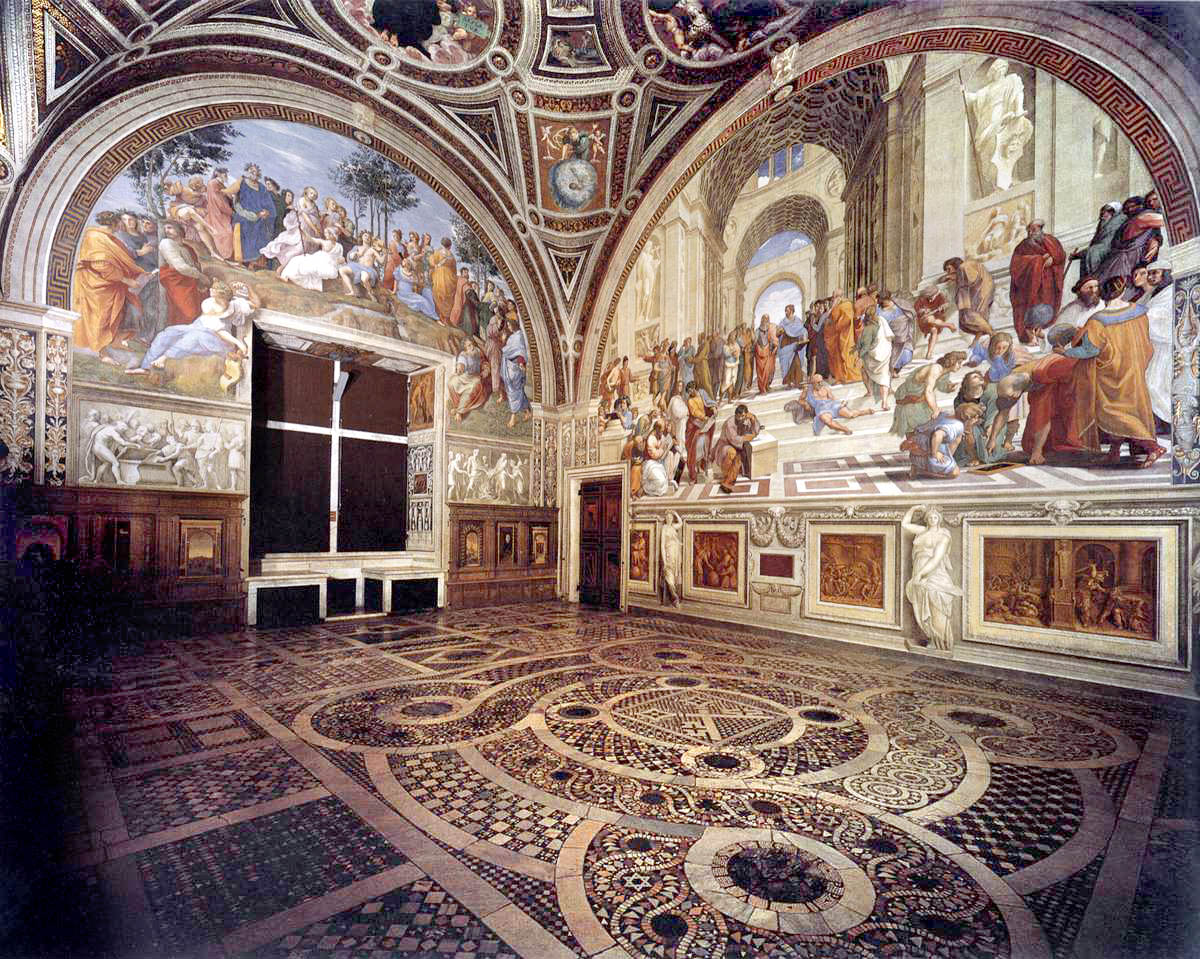
Stanza della Segnatura
1509-10
Fresco
Vatican, Rome
1508 Pope Julius II commissioned Raphael to decorate the papal apartments
4 large rooms (Stanze)
Serve as the pope's residence
Julius II refused to live in the apartments of the previous pope
Segnatura means signature (used as a library) and first to be decorated (1509-1511)
Theology, law, poetry and philosophy are the themes of the walls
4 branches of human knowledge
Neoplatonic concepts present here
Disputa (law), School of Athens (philosophy)
parnassus( theology), Virtues and rulers (justice)
The program for the setup of the room comes from Theologian,
Across from the disputa is philosophy, pre Christian search for knowledge that is complete through the finding of religion
Parnassus representing the arts
Law, divided by civil and canon law
The harmony of all these aspects completes all aspects of knowledge
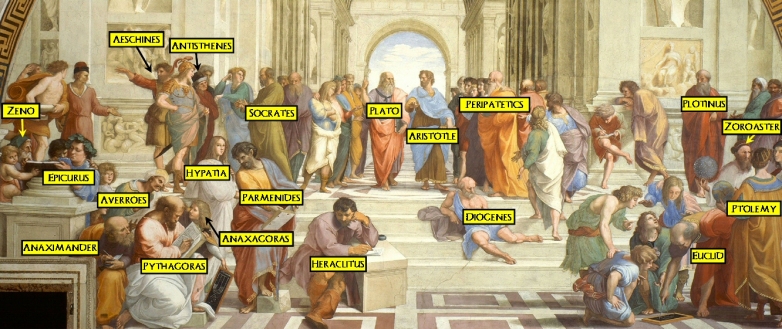
School of Athens (Philosophy Wall)
1509-1510
Fresco
Vatican, Rome
19 ft x 27 ft
Represents philosophy and the pre-Christian search for knowledge.
Set in an ancient Roman bathhouse with coffered ceilings, creating a classical space.
Central figures: Plato (modeled after Leonardo da Vinci) and Aristotle.
Plato holds Timaeus and points to the sky, emphasizing metaphysical ideals.
Aristotle holds Ethics and gestures toward the earth, emphasizing empirical knowledge.
Other figures:
Socrates (green, on Plato’s side).
Epicurus (blue, left corner).
Pythagoras (foreground, writing on a board).
Michelangelo included as a figure.
Uses linear and atmospheric perspective.
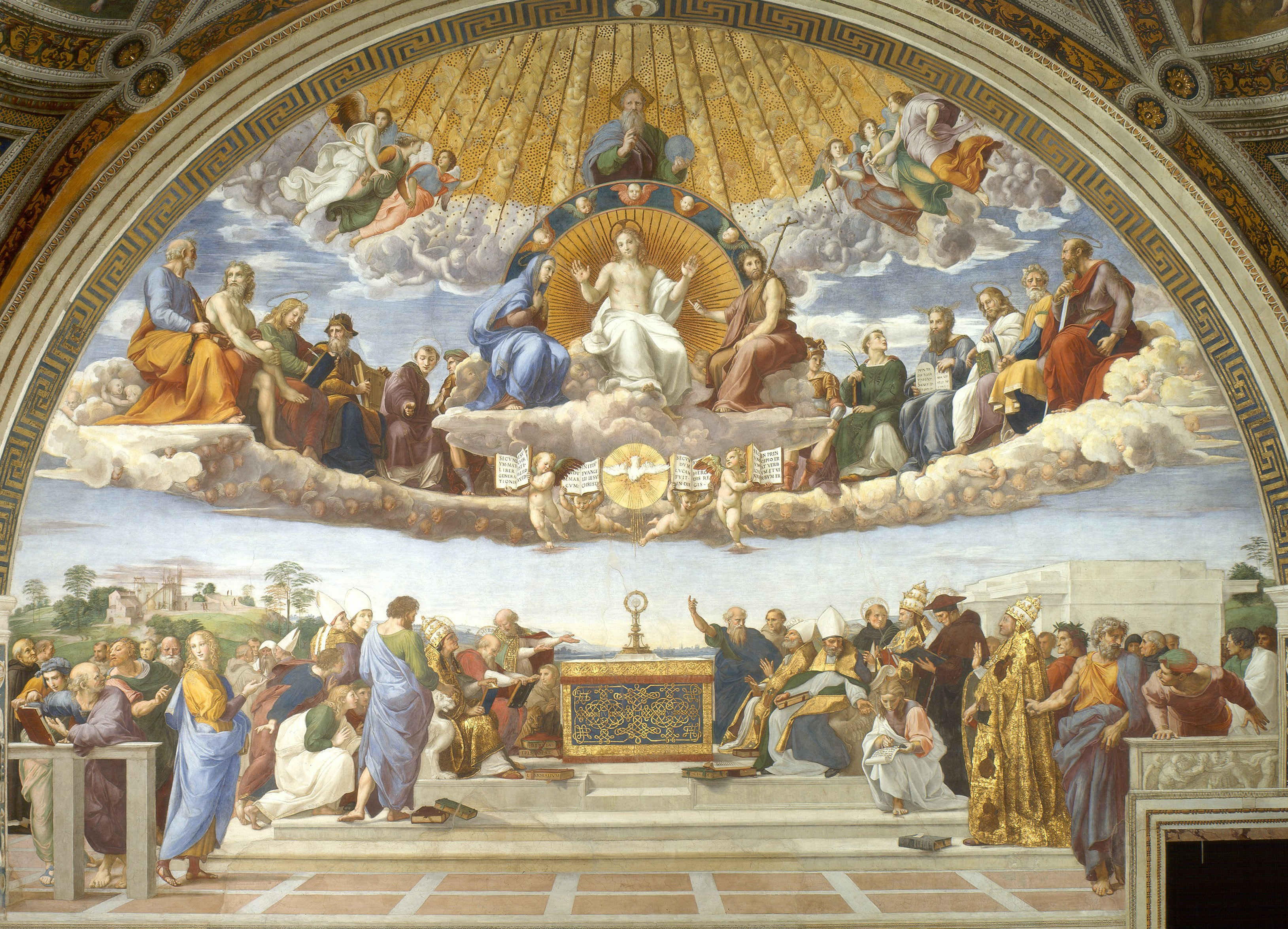
Disputa (Disputation of the Holy Sacrament) (Theology Wall)
1509-1510
Fresco
Vatican, Rome
19 ft x 27 ft
Also called Triumph of the Church.
Double-decker composition: Church Militant (earthly) and Church Triumphant (heavenly).
Heavenly realm:
God the Father at the top.
Holy Spirit in a golden orb.
Christ in the center, flanked by the Virgin Mary and John the Baptist.
Old and New Testament figures surround them.
Earthly realm:
Large monstrance on an altar represents the Eucharist (Christ’s body, transubstantiation).
Figures include St. Peter, Moses, St. Paul, and other religious leaders.
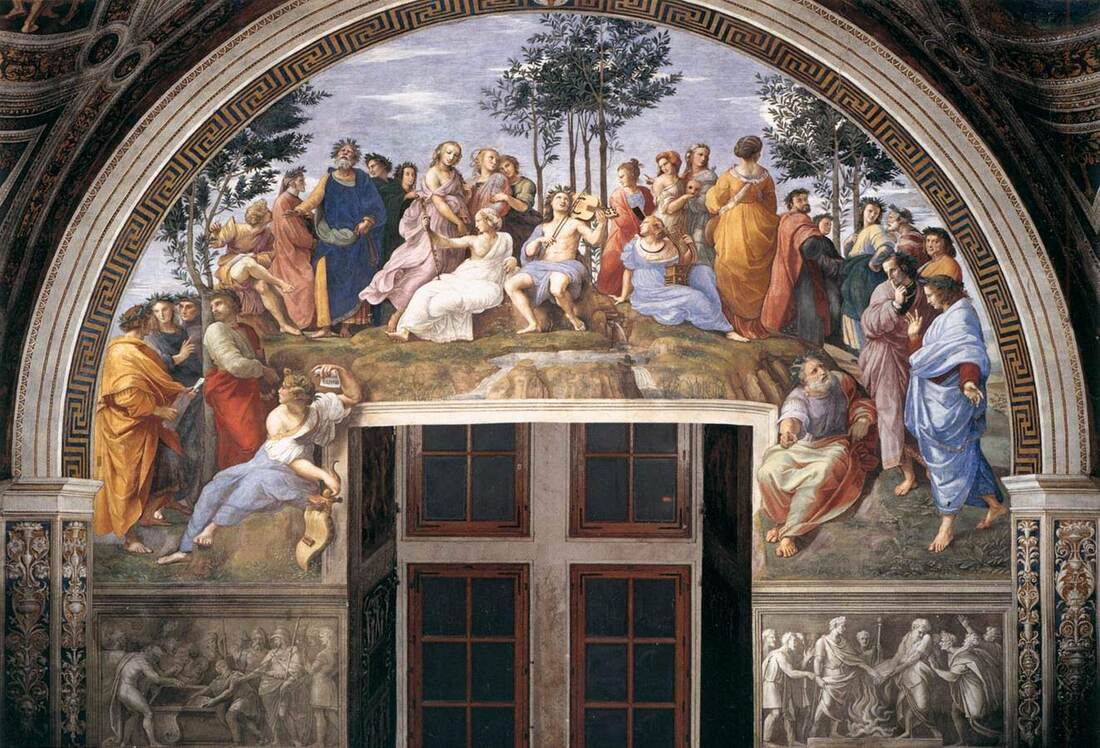
Parnassus (Poetry Wall)
1509-1510
Fresco
Vatican, Rome
Represents poetry and artistic inspiration.
Central figure: Apollo, wearing blue drapery under a laurel tree.
Surrounded by the Nine Muses, who inspire the arts.
Calliope, the Muse of Epic Poetry, sits next to Apollo in white.
Homer, blind, depicted in blue and yellow robes.
Fountain: Castalia, symbolizing poetic inspiration.
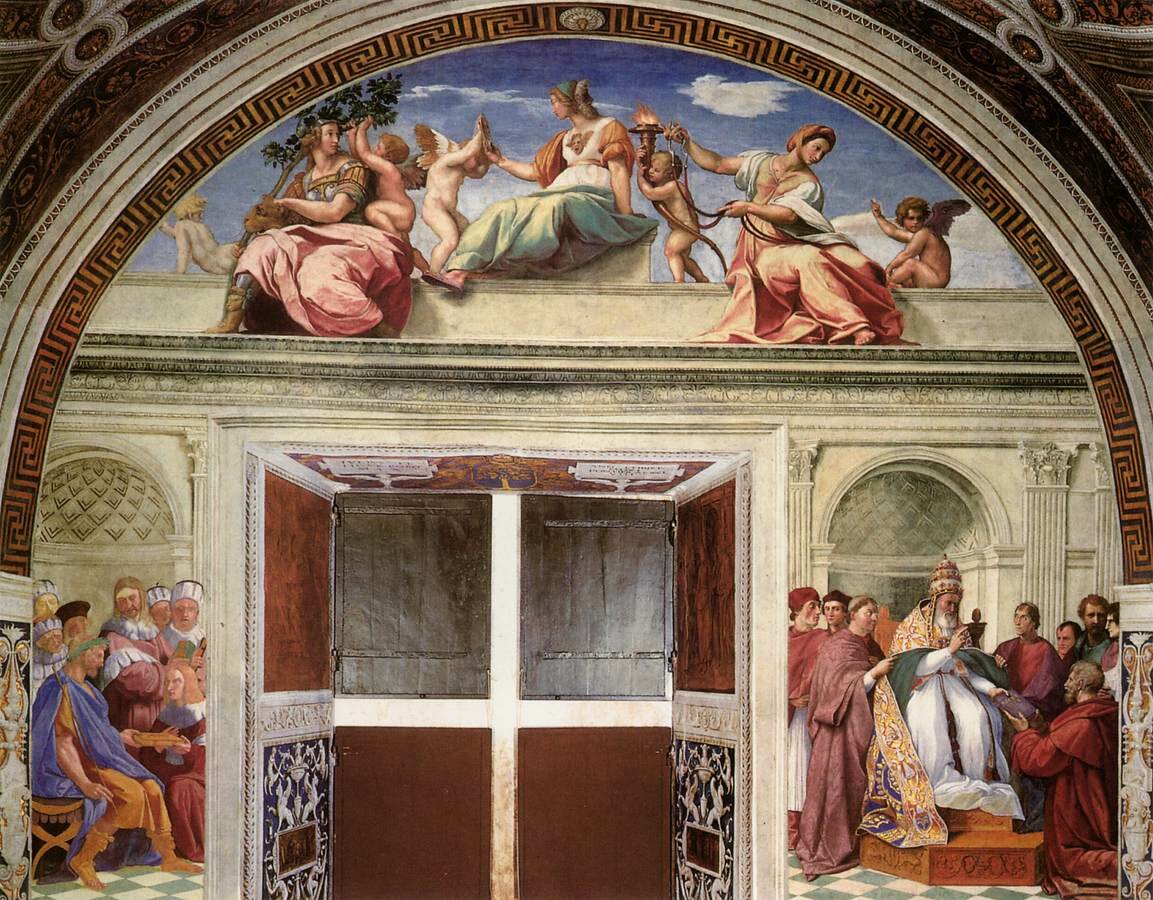
Law (Justice Wall)
1509-1510
Fresco
Vatican, Rome
Represents law, divided into civil law and canon law.
Top lunette:
Temperance (right), Fortitude (left), and Prudence (center).
Justice depicted in the vault above.
Figures on either side of the window:
Left: Emperor Justinian I (represents civil law).
Right: St. Raymond (receiving canon law).
Fresco balances free thinking with the necessity of justice and law.
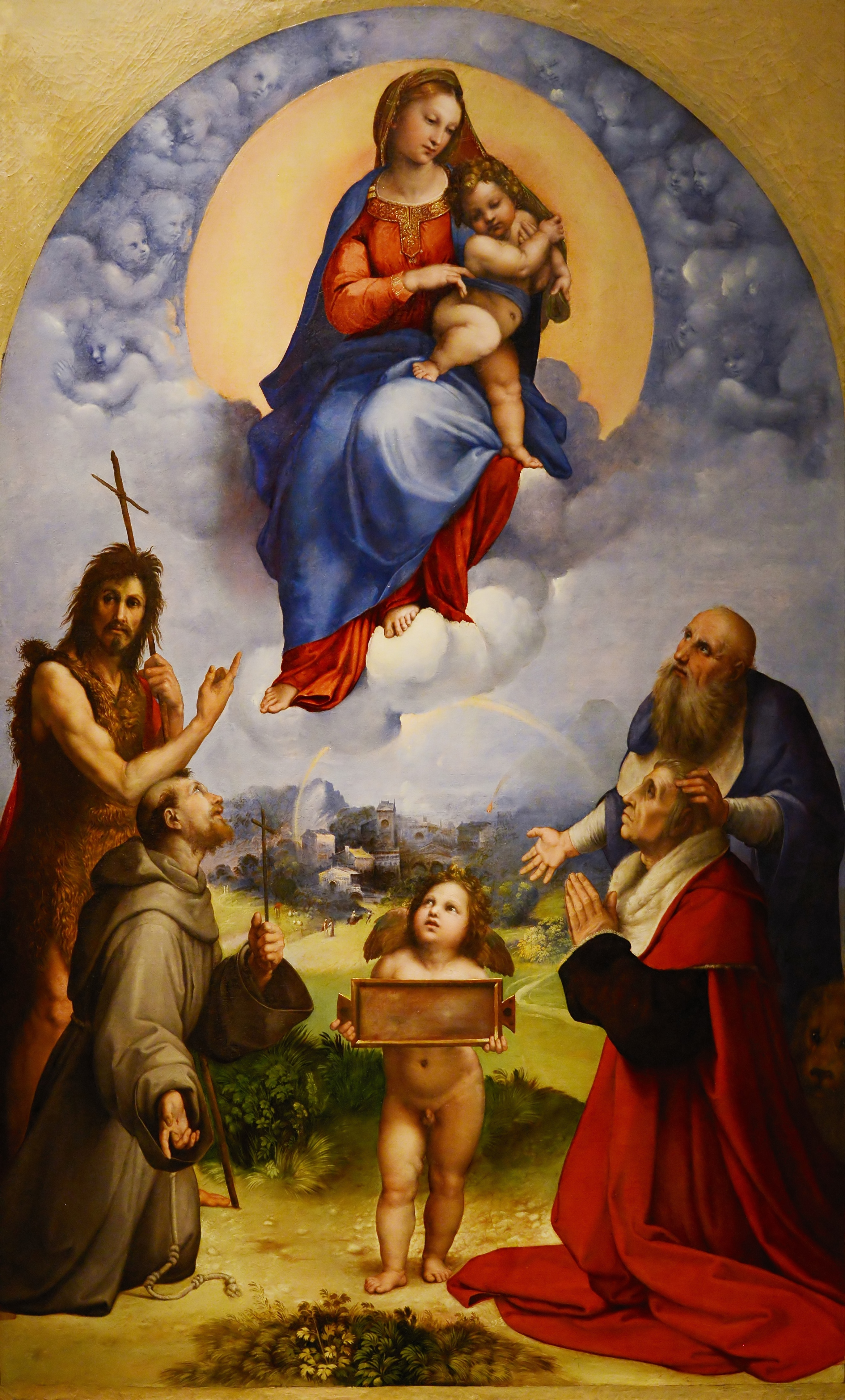
The Madonna of Foligno
1511-12
Oil on wood
Pinacoteca Vaticana, Vatican, Rome
11 ft 3 x 6ft 3
oil on panel transferred to canvas
Conti commissioned to stand on the high altar of the Church of Aracoeli in Rome.
Depicts the town of Foligno in the background because that is where the commissioner was from
Franciscan church at the time
Conti was a member of the clergy, and private secretary for Pope and possibly cardinal (seen in a red cardinal robe in the painting)
To honor VM for saving his home after it was hit by the object in the painting
preparatory drawing for this work
Clouds composed of cherubs and the VM and Christ are framed by a huge halo or mandorla
St. Francis in a grey robe, St Jerome in blue
Christ holds a Tabula assanta
Arch of the crescent moon sometimes used a symbolism for the VM
The emotive expression of St,.Francis anticipates the emotive depictions of saints during the baroque period
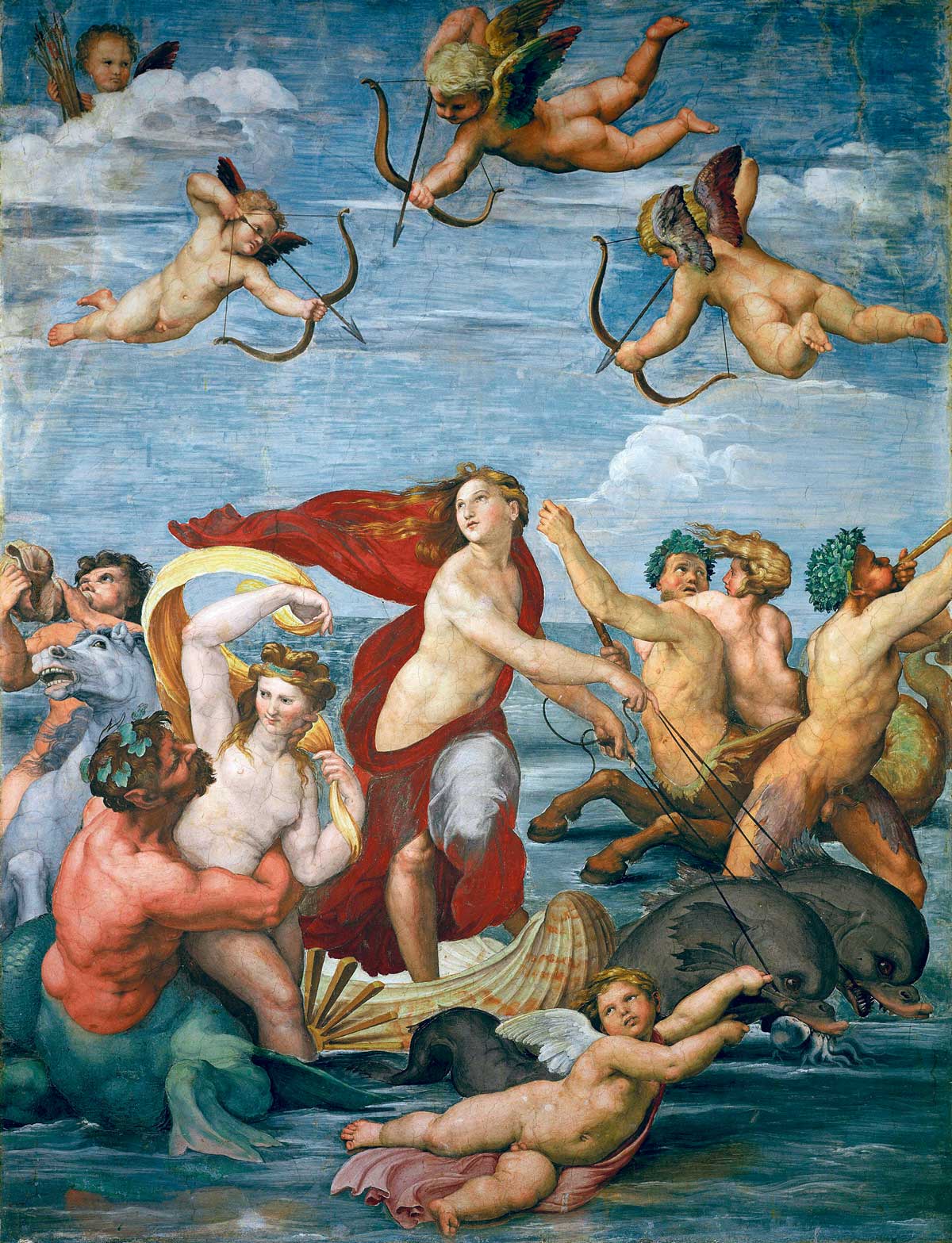
The Triumph of Galatea
1511-13
Fresco
295 x 224 cm
Villa Farnesina, Rome
Next to a fresco of polycleidus
Galatea on a chariot
Polycleidus is in love with Galatea
double decker composition
influence of the sistine ceiling
Raphael’s only
The work seems completely separate from the Polycleidus work and orgininally had a painted frame completely separating the two
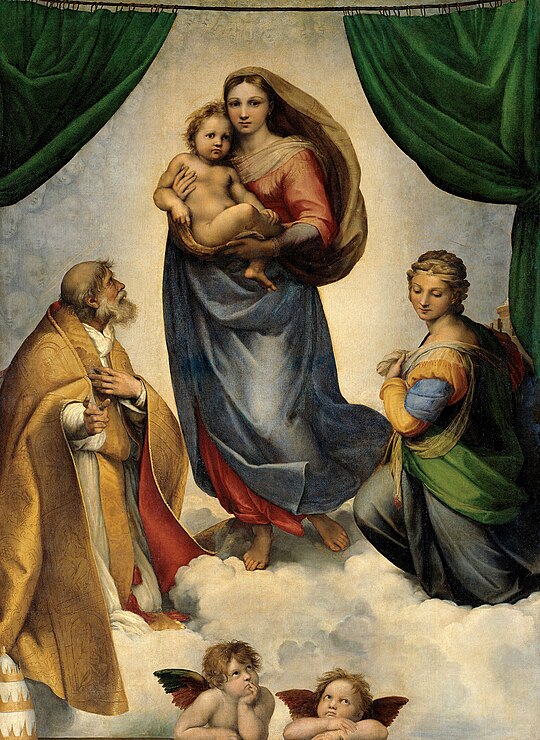
Sistine Madonna
c. 1513-14
Oil on canvas
265 x 196 cm
Gemäldegalerie Alte Meister, Dresden
8ft 81/2 by 6ft 12
Commissioned by Pope Julius II
part of the decoration for the pope’s funeral
Kneeling Saint sixtus I is the patron saint of the della rovere family and also depicted as a portrait of pope Julius II
Saint Barbara on the right, the tower is her symbol
The puti beneath them may just be decorative
one of the most known works of it’s time and highly influential8ft 81/2 by 6ft 12
Commissioned by Pope Julius II
part of the decoration for the pope’s funeral
Kneeling Saint sixtus I is the patron saint of the della rovere family and also depicted as a portrait of pope Julius II
Saint Barbara on the right, the tower is her symbol
The puti beneath them may just be decorative
one of the most known works of it’s time and highly influential
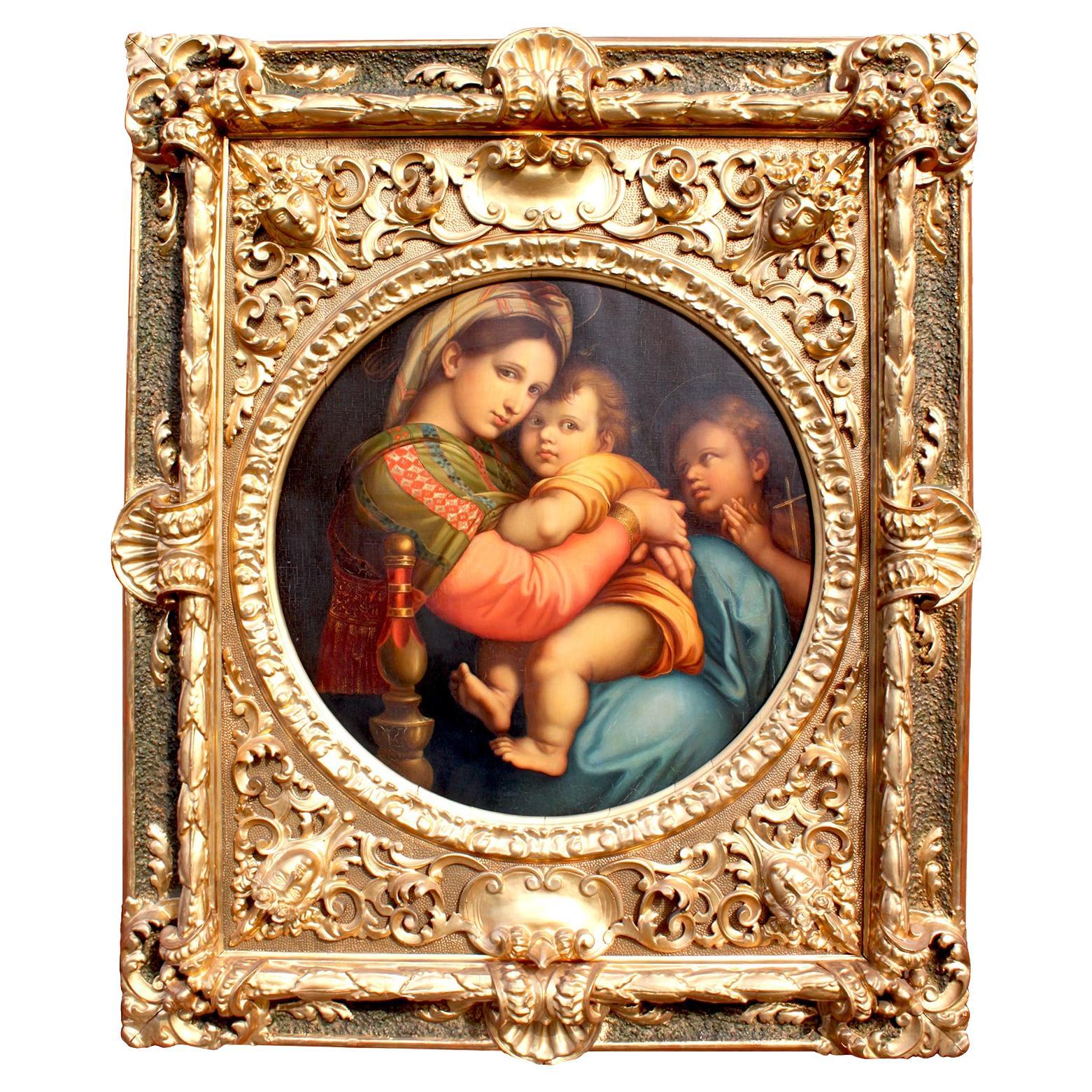
Madonna della Sedia
1513-14
Oil on wood
diameter 71 cm
Galleria Palatina (Pitti), Florence
Sedia (chair)
30 in in diameter
On a hinged frame
no documents related to this work
in Rome in the 1570’s and in the 1580’s back in the Florence with the Duke
representative if Raphael’s more mature madonnas with her darker Roman features
Referred to as madonna of the people
Margarita Luti (?) daughter of a baker that Raphael had an affair with her
Madonna wears an eastern inspired head scarf
John the baptist to her right with worshiping hands
VM and child look at the viewer
VM has an exaggerated sitting pose with her knees draped in blue
A softness to the color and figures
Reminiscent of Ruvine and venetian painting
An intimate and domestic scene
Likely intended for private devotion not
Legend about an innkeeper's daughter and her child and painted them on the top of the wine barrel

Woman with a Veil (La donna velata)
1514-16
Oil on canvas
33 x 23 in
Palazzo Pitti, Florence
Dressed in silk
example of Raphael’s more mature madonna
Harmonious color scheme
Shows his exposure to Venetian coloring
Regal and serene sitter but not a confrontational gaze
Woman of wealth with her adornments and sleeves
and the veil suggests she is a pious woman
If she is a real woman she is like
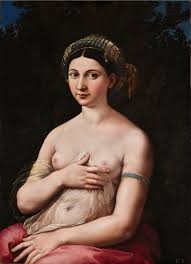
La Fornarina
1518-1519
Oil on wood
85 x 60 cm
Galleria Nazionale d'Arte Antica, Rome
“The little baker girl”
Same woman in La Donna velata
bare to the waist and the same jewelry
Trimmed blue ribbon on her arm also where Raphael signs the painting claiming both the woman and the painting
She originally had a ring on her left ring finger
In 1514 Raphael was forced to be engaged
Her ring was painted out and revealed in restoration
Julio Romano likely painted the ring out to save the secret after Raphael dies
May have been a private portrait or a marriage portrait
She sits before a Myrtle tree often associated with marriage
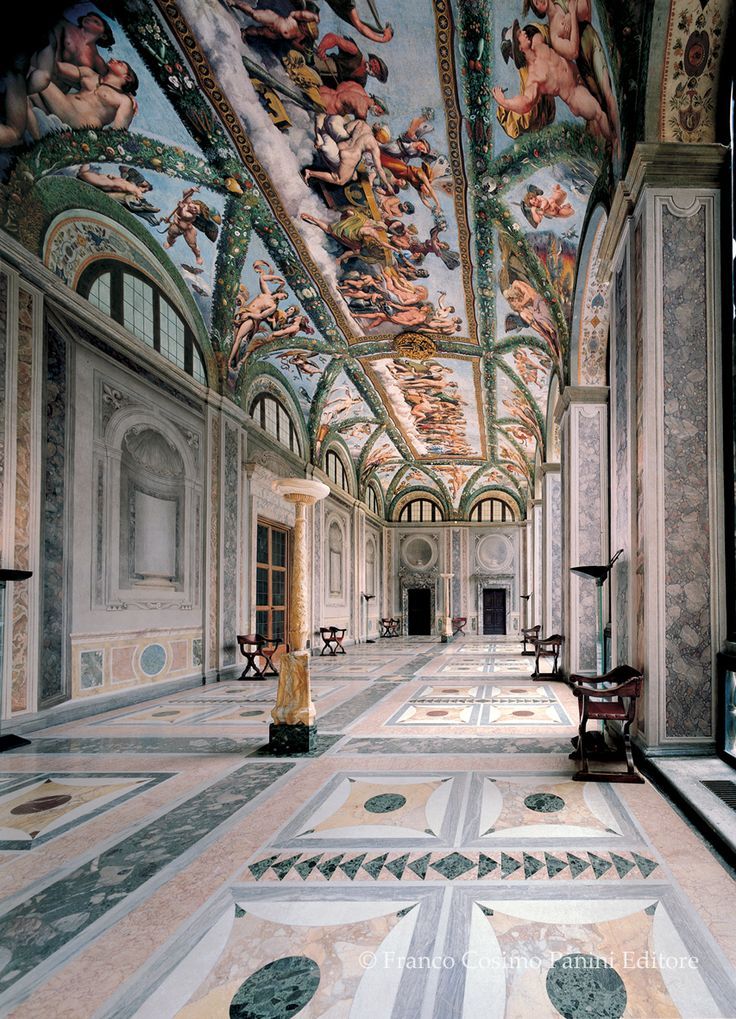
Logia de Psyche
1518
Fresco
Villa Farnesina, Rome
1517 Augustino Cigi commissioned the frescoes for wedding to Francesca Odiesci
Cupid and psyche points to their own marriage
Gather and dine in the loggia after the wedding
Proto Baroque with an open pergola
The ceiling read like tapestries
Fruit and vegetable and flower garlands with greenery from all seasons
Garlands are not by Raphael
Two center panels depict the end of the myth
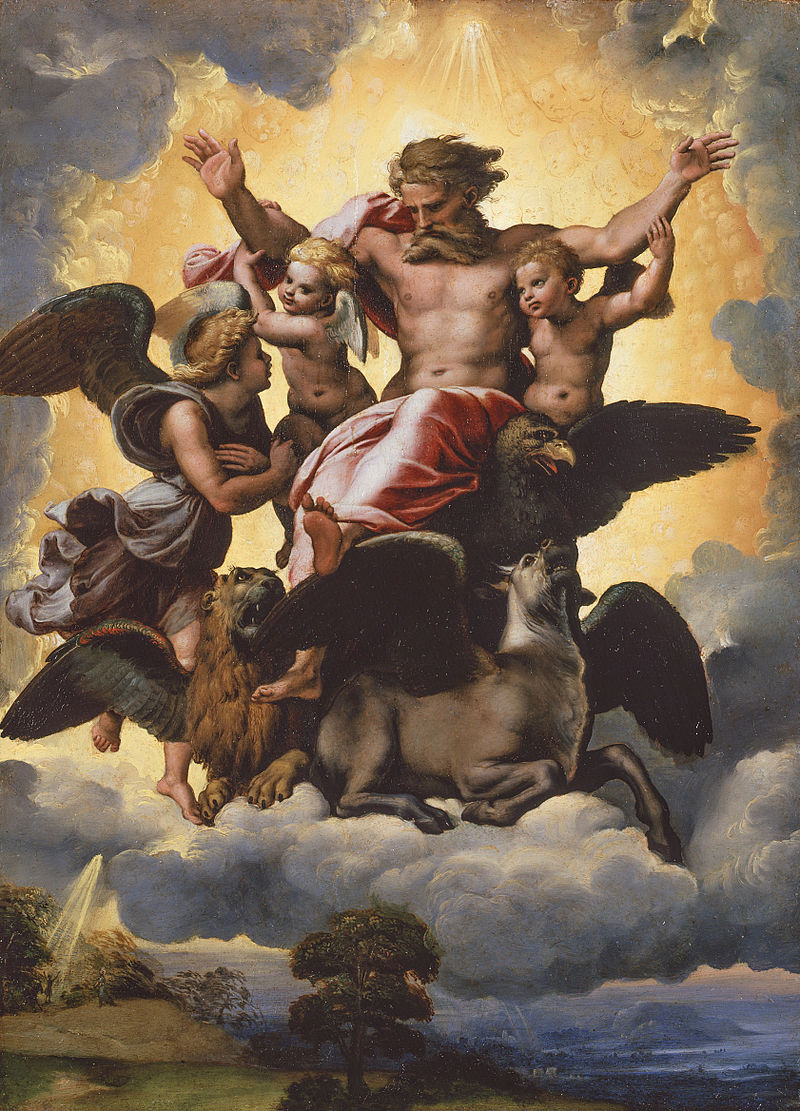
Ezechiel’s Vision
1518
Oil on wood
40 x 29 cm
Palazzo Pitti, Florence
Vincenzo Erconalni commissioned it
stylistically inspired by the Sistine chapel
been in Florence since 1589
ezichiel prophesied the destruction of the temple of Jerusalem
man sits on a throne of 4 figures symbols of the evangelist
Ezechiel is on the shore with the light shining upon him
Double decker composition
Vissari believes the work to be a vision of st.john exiled on patmos
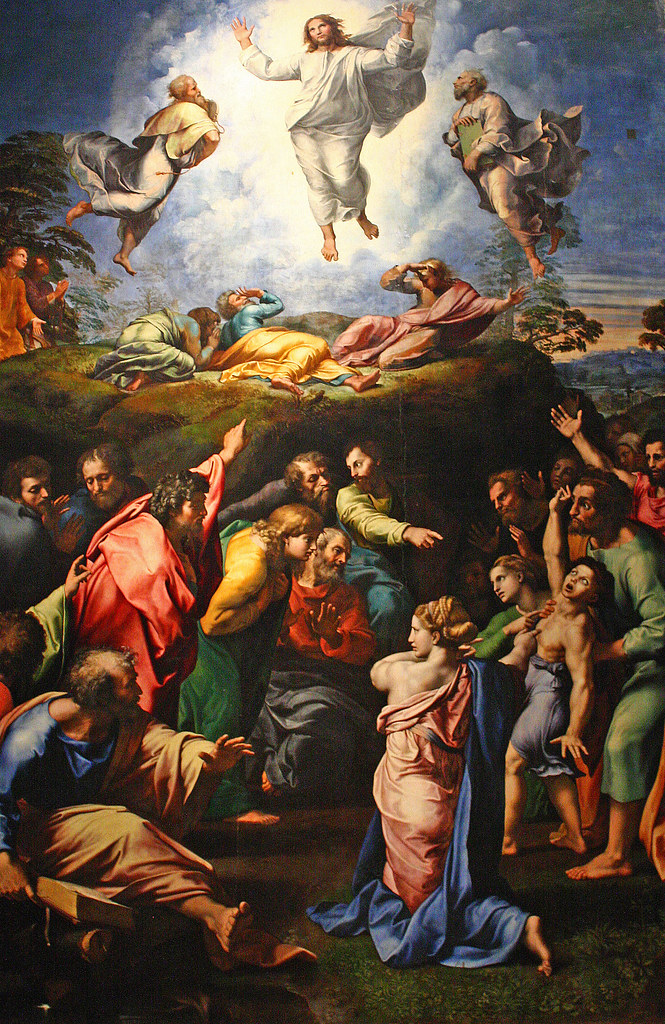
Transfiguration
1517-20
Oil on wood
405 x 278 cm
Vatican Museum, Rome
160 x 109 in
commissioned by cardinal Julio de Medici, named archbishop in the cathedral of Narbonne
Gift for the cathedral
double decker composition
below: miracle of the possessed boy bringing the boy to the apostles
above: transfiguration
The description in the gospel is what happens after this scene
Raphael’s final work, placed at his funeral
Raphael was buried in the pantheon upon his request
His finance was buried to his right